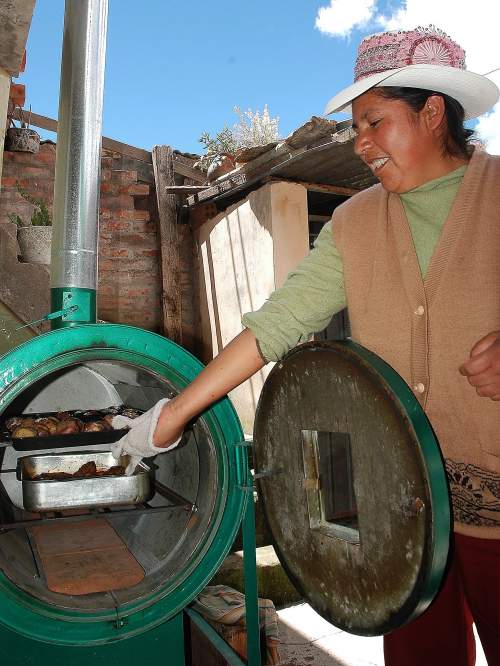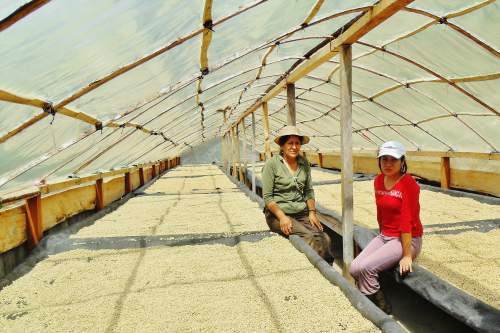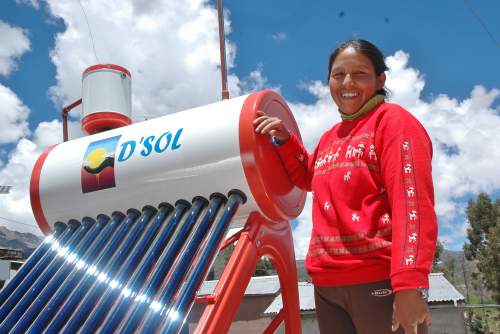Knowledge fuels change - Support energypedia!
For over 10 years, energypedia has been connecting energy experts around the world — helping them share knowledge, learn from each other, and accelerate the global energy transition.
Today, we ask for your support to keep this platform free and accessible to all.
Even a small contribution makes a big difference! If just 10–20% of our 60,000+ monthly visitors donated the equivalent of a cup of coffee — €5 — Energypedia would be fully funded for a whole year.
Is the knowledge you’ve gained through Energypedia this year worth €5 or more?
Your donation keeps the platform running, helps us create new knowledge products, and contributes directly to achieving SDG 7.
Thank you for your support, your donation, big or small, truly matters!
Use of Microfinance Institutions (MFI) for Renewable Energy Technologies
► Back to Financing and Funding Portal
Introduction
In order to function properly, incentives must be created for different actors to participate in microfinance schemes.
- Awareness campaigns are needed in order for families to fully understand the benefits of accessing new and cleaner technologies for energy supply. Evidence has shown that in many cases families are not accustomed to participate within financial schemes and thus fear taking on such risks and obligations with a formal micro-financing institution. Explaining how these schemes may be adjusted to their economic needs and capabilities is very important when helping families feel more confident in accepting a credit.
- Accessing other products such as savings accounts may also be necessary for families. As in the case of most modern technologies, these may require a periodic maintenance and occasional repair; therefore it is important for families to create funds destined to cover the costs associated with these activities. Experiences in Bolivia have shown that certain MFIs have combined these products (credits and savings accounts) within a small-scale financing scheme by increasing the monthly payment of the family enough to cover not only the credit, but also create a savings account. This not only ensures that the family will automatically have a small fund saved once their credit has been fully paid, but also ensures the MFI a customer with a new product.
- For small-scale financing institutions, these loans may represent an attractive new business once the scheme is sustainable. However, as the document well stated, most institutions are hesitant to bear the risk of giving out loans for new technologies and it may be necessary for the government (or other cooperating agencies) to help mitigate such risk by offering guarantees to these institutions (but only in the first phases). Once the functionality of the technology has been proven, the institutions will bear their own risk and the guarantees will not be needed.
- For larger scale financing institutions, the loans may possibly not represent an attractive new business. However, these institutions tend to develop a much more social sense than small-scale MFIs. In Bolivia, these larger scale institutions tend to incorporate funds for such projects within their annual budget. Therefore, these institutions have a social incentive to participate within these schemes and are also open to bear certain administrative costs within the process of promotion and dissemination of the technology and financial products.
- Capacity building and training will definitely play an important role within these schemes, families must be well trained on the correct use and maintenance of the technology.
- Transportation costs and time of delivery are crucial when credits are involved. Families feel the pressure of having a new economic obligation (monthly payments to the MFI) and will demand to have their technology delivered as soon as possible and in perfect working conditions at all times.
In Bolivia, these small-scale financing schemes have been strongly concentrated on the benefit awareness of the technology as well as training on the correct use and maintenance.
A strong social sense has been developed within the microfinance institutions (MFIs) and energy technology distributors. In many cases, both actors have coordinated efforts in order to impulse promotion campaigns and workshops, as well as cover certain costs of transportation and time reduction in the delivery of the technology.
Guarantees have also been offered within pilot projects in order to impulse activities and gain the confidence of the MFI in the new technology. However, the most successful results have come from the more independent schemes where the Deutsche Gesellschaft für Internationale Zusammenarbeit (GIZ) has limited its support to coordination of activities, supervision of outcomes and financial support of promotional material.
Project Examples
MFI in Peru
Introduction
Microfinance institutions (MFI), such as municipal banks, financial banks or Edpymes -which offer small loans in Peru– are characterized by the personal relationship they have with their customers. MFIs know the needs of their clients and offer tailored financial services, while, at the same time, provide the human resources and organizational structure necessary to serve a lowincome population.
This segment of the population is usually found in rural or suburban areas. It is precisely this demographic which needs support in order to access basic energy services. These people are not connected to the electric grid or they might have an unreliable connection and regularly suffer from blackouts, leading to the use of fossil fuels and damage to appliances from energy surges. Cooking with firewood, coal, or charcoal puts people’s health and safety at risk, especially those
of women and children, by creating household pollution. Furthermore, the lack of a reliable energy source creates dependence on diesel generators, batteries or small rechargeable car batteries, which can cost as much as half of a
household's monthly income.
To address this problem, access to "green" energy services must be presented as the solution. However, these environmentally friendly technologies represent an investment that many people cannot afford. The loan that MFIs can provide can be, in many cases, the key factor that drives customers to adopt clean energy technology, which is financially viable in the long term but expensive at the time of acquisition.
Taking on the challenge
Considering the aforementioned dilemma, in 2010, the NGO from Luxembourg, Appui au Développement Autonome (ADA) and the German consulting company, MicroEnergy International (MEI), jointly developed the "Micropower Atlas", which estimates the potential for microfinance funded energy projects from an analysis of indicators from both sectors. The study highlighted the potential of Peru as a country that has a mature microfinance market (it is considered the industry leader in Latin America) and has optimal energy conditions (it received one of the highest solar annual averages in the world: 2300 kWh/m2). This is why it was chosen as the country to implement the pilot project of the Energy Inclusion Initiative (EII), which supports both European institutions to provide disadvantaged people with access to "green" technologies through microfinance.
Thus, a partnership was established with the Energising Development Project of the German Agency for International Cooperation, GIZ, in Peru (EnDev/GIZ) and the MFIs, Caja Huancayo and Fondesurco to implement the projects. Both institutions were selected for their high level of motivation, experience and management skills, to take on the challenge of diversifying its portfolio with a micro-finance energy program and creating a triple impact with its work: economic, social and environmental.
| The results of the research identified solar water heaters, improved ovens and solar dryers, as technologies that meet the energy needs of its customers. (©Fondesurco) |
"Bottom Up" Approach: Costumer Needs
Technologies that could incorporate the MFIs’ financial programs were selected through a methodology that prioritizes the energy needs of current and potential customers. Through a field study, information was collected on the uses of energy and energy costs of each institution, as well as analyses of the breadth and quality of the supply of clean energy technology.
The results of the research identified solar water heaters, improved ovens and solar dryers, as technologies that meet the energy needs of its customers, in order to promote access to clean energy and to significantly improve the financial situation in households and for entrepreneurs, which can put these products to good use. Renewable energy systems, such as solar water heaters, give a competitive edge to the lodges that install them, because by offering hot water service to tourists, they can increase their prices. Solar dryers for coffee, which protect the beans during drying, reduce waste by 80% in comparison with traditional drying methods. Meanwhile, the improved ovens save up to 50% of fuel consumed using traditional ones and also reduces household pollution by 99%.
Once the specific technologies were selected, partnerships with local suppliers were established after a detailed technical assessment. All equipment was validated by EnDev/GIZ and MEI personally, in order to guarantee that it will function properly in the climatic conditions of the regions where the MFIs are located: the highlands of Junín, Arequipa and Satipo, in the Amazon.
| Solar dryers improve the productivity of small businesses.(©MicroEnergy International) |
Growing together: The first lessons
The implementation of the EII in Fondesurco and Caja Huancayo, with its Renewable Energy Solutions (SER) program and Green Line Program(PLE), has been carried out methodically, adapted in each case to the characteristics of the institution
and its work areas. This was designed and launched in mid-2011, with loans specifically to finance energy technology: Crediecológico in Caja Huancayo and FondeEnergía in Fondesurco.
Marketing loans for energy technology presented a number of challenges for both the MFIs and suppliers. Both had to adapt their work methods to establish an efficient supply chain to meet the needs of customers: from the soliciting loans to
the acquisition of the technology, to the maintenance service after the sale, to the transportation and installation of the equipment.
These efforts are beginning to bear fruit, as now around 200 energy systems have been placed in households and small businesses, and the potential for growth is encouraging. The results of the evaluation of the first phase of the project SER, under Fondesurco, have reaffirmed the potential of these types of energy programs and customer satisfaction with green energy technology: 85% believe the quality of the equipment is good or very good and 100% would recommend the technology to relatives and acquaintances.
The next step is marketing on the small scale: the MFIs will provide more loans to agencies and regions to acquire green technologies. Further challenges arise from consolidating the supply chains. While MFIs focus their efforts on promoting these products by acquiring expertise in the field of clean energy, providers are prepared to supply the regions where energy programs areestablished.
Establishing providers is an important step towards the success of the project, which has recently signed an agreement with the NGO Hivos to implement a program to strengthen the providers of each program. Thanks to this initiative, the microfinance market is fostering the development of green energy in the country.
| The loan that MFIs can provide can be, in many cases, the key factor that drives customers to adopt clean energy technology. (©Fondesurco) |
References
This article was originally published by EnDev Peru in the second issue of the Amaray Magazine - Energising Development Peru published in November 2012 (Amaray N°2).






















